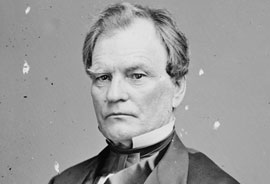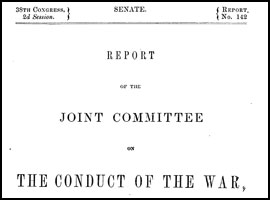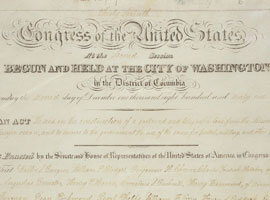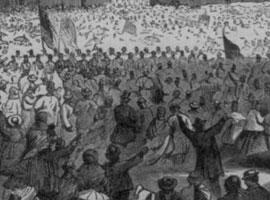The Senate’s Work Continues
The Joint Committee on the Conduct of the War
The defeat at Bull Run in 1861 was the first in a series of military disasters for the Union. As casualities mounted, including the loss of Senator Baker at Ball’s Bluff, many Americans in and out of Congress demanded explanations. In the opening days of the 37th Congress in 1861, the public and elected officials called for an inquiry into events surrounding the dramatic defeats suffered by the Union army. Senator William Pitt Fessenden of Maine articulated the thoughts of many when he said, “We see many things done which do not meet the public approbation. We see some things done which we do not approve ourselves, and which evidently call for an investigation, or, at any rate, call for such an explanation as shall satisfy the people.”
In that spirit, Senator Zachariah Chandler introduced a resolution on December 5, 1861, to investigate the battles at Bull Run and Ball’s Bluff, while other senators demanded a broad inquiry into the conduct of the war. Consequently, Senator James Grimes amended the resolution, calling for a joint committee to examine all aspects of the war. The concurrent resolution, passed on December 10, 1861, created a joint committee composed of three senators and four representatives and granted its members the power to “inquire into the conduct of the present war and to send for persons and papers.” Five Republicans and two Democrats served on the committee, reflecting Republican control of the Civil War Congress. Traditionally, the senator who proposed the resolution chaired the committee, but Chandler deferred to his close friend and colleague Senator Benjamin Wade, believing that the Ohioan’s legal background made him particularly well suited for directing the investigation.

At its first meeting, members of the joint committee agreed to keep their deliberations secret. Meeting in a Senate committee room, the joint committee held no public hearings and forbade those who testified from speaking with the press. Committee members, however, regularly broke their own rules by leaking information to the newspapers to generate public support for their efforts. In March 1862, for example, committee members leaked the written statement of General John C. Frémont, commander of the Western Department and a favorite of the committee, to the . They hoped to enlist public opinion behind General Frémont’s controversial actions in the field, and to draw upon this well of public support to lobby Lincoln for Frémont’s reappointment.
“Radical Republicans,” the faction of the Republican Party with the strongest anti-slavery views, dominated the committee and frequently criticized the president’s war strategy for not being aggressive enough on the issue of slavery. Senator Wade, irritated by the president’s gradual approach to emancipation and equality for African Americans, dismissed Lincoln as “a fool.” The joint committee itself faced criticism from Washington insiders who denounced its work as misguided and ill-informed. Critics noted that the joint committee was well-intentioned, but that its members had no military experience and seemed unqualified to analyze war-related decisions and the commanders who made them. Some military leaders dismissed the inquiry as partisan or ideological and not in the nation’s best interest. Washington journalist Benjamin Perley Poore denounced the committee as “a mischievous organization, which assumed dictatorial powers.”
Regardless of such criticism, the Joint Committee on the Conduct of the War pursued a broad investigatory agenda. In addition to examining failed military campaigns, the committee scrutinized a number of wide-ranging issues, including corruption in military supply contracts, the mistreatment of Union prisoners by Confederate forces, the massacre of Cheyenne Indians, Union trade activities, and gunboat construction, to name just a few. The joint committee worked through two Congresses, meeting 272 times over four years. Subcommittees were formed to maximize time and resources and meet with as many witnesses as possible. Members frequently traveled outside of Washington, D.C., recording testimony from witnesses and making first-hand assessments of the war effort.
Despite Senator Wade’s withering assessment of Lincoln, the joint committee maintained friendly relations with the executive branch. Both President Lincoln and his successor Andrew Johnson (a former member of the joint committee), and their cabinets, complied with committee requests for meetings and access to information. Members of the joint committee frequently blamed military commanders for Union losses, often accusing them of disloyalty to the government, and they pressed for changes in military command. They strongly encouraged Lincoln to remove Major General George McClellan from command of the Army of the Potomac after successive losses early in the war. The president eventually relieved McClellan in November 1862, but he did so on his own terms, and largely disregarded the joint committee’s recommendations. The joint committee proved more convincing in another case, however, and the president acquiesced to its demands that he approve the arrest and imprisonment of Brigadier General Charles Pomeroy Stone. The committee had long questioned Stone’s loyalty and blamed him for Union defeats.

The Joint Committee on the Conduct of the War produced volumes of copious reports based on its field work and the testimony of dozens of witnesses. Published periodically throughout the committee’s four-year tenure, these reports were often summarized in newspapers. Nevertheless, compared to other congressional investigations, the work of the Joint Committee on the Conduct of the War remained mostly unknown to the American public. Despite this low-profile status, the committee’s investigations fulfilled the congressional responsibility for oversight during a time of national crisis. Committee members felt satisfied that their inquiry prompted President Lincoln to more carefully consider the strategy and evaluate the performance of his top field commanders. Interviews with military commanders provided detailed accounts of action in the field, while creating a record of wartime events that otherwise would not have been recorded.
Legislative Work Continues
As the Senate faced the military challenges of the Civil War, senators also fulfilled their legislative responsibilities by dealing with the economic consequences of the war effort. Senator John Sherman observed that the country’s greatest challenge “was not whether we could muster men, but whether we could raise money. We had to create a system of finance that would secure an enlarged revenue.” Finance Committee chairman William Pitt Fessenden, who confessed his “great anxiety” about creating revenue streams to prevent the nation from becoming “bankrupt, [with] specie payments suspended, and the government living on its own discredited notes,” worked feverishly to draft legislation to avert a crisis. Under Senator Fessenden’s leadership, the Finance Committee sponsored bills that proved vital to funding the war. The Revenue Act of 1861 established the first federal income tax. A second revenue act, which became law on July 1, 1862, created the Bureau of Internal Revenue within the Treasury Department and established taxes on some luxury items. Senator James Blaine of Maine later called it “one of the most searching, thorough, comprehensive systems of taxation ever devised by any Government.” A third piece of revenue legislation became law on June 30, 1864, increasing the progressive income tax rates established in 1862 and adding a tax to some consumer goods including tobacco products.

Another persistent challenge was the low number of men volunteering to serve in the Union army. Senator Henry Wilson, chairman of the Committee on Military Affairs, sponsored the Conscription Act of 1863, which established the first national draft system and required registration by every male citizen and immigrant who had applied for citizenship between the ages of 20 and 45. The called the Conscription Act “the condition of victory,” but many people criticized the law because it provided an exemption for those who could pay a $300 fee. Some critics argued that the law punished the poor, while others insisted that it interfered with states’ rights, since state-based militias had fought in previous wars. Even with such conscription laws, however, both the Union and Confederate armies continued to rely mostly upon volunteers.
Eager to equip the Union army with the tools it needed to succeed, senators pushed for legislation to punish the rebels and assist Union troops. “I would do everything to strike at the rebel; confiscate their land, their houses, their slaves, anything,” declared Senator Sherman. “When they take up arms against this Government, when they commit the act of rebellion, they forfeit their lives by the Constitution of the United States; they lose everything.” To punish rebelling states, Senator Lyman Trumbull of Illinois sponsored confiscation acts, the first of which was signed into law on August 6, 1861, and allowed Union forces to seize all property used to aid the Confederate cause. A second confiscation act, approved in July 1862, intentionally sought to, in the words of one historian, “deprive the enemy of slave labor.” It granted the Union army the ability to seize the property, including slaves, of anyone who supported the rebel cause. The New York Times declared the measure a “military necessity,” since enslaved persons could be seized and “use[d] to our advantage in behalf of the Union.”
The Senate was also remarkably productive in enacting legislation not connected to military needs, including passage of landmark legislation for the homestead settlement of western lands, the expansion of railroad lines, and the establishment of land-grant colleges. Throughout the war years, the Senate operated, according to Senator Sherman, like “a laborious committee where bills are drawn as well as discussed.” For decades Congress had argued over such issues, only to have them blocked by states’ rights advocates, largely from the South. Northern senators therefore took advantage of the absence of the Southern lawmakers to pass a series of historic bills that previously had fallen victim to sectional conflict.

Since the rapid settlement of the western territories in the 1850s, most members of Congress agreed on the need for efficient rail transport to the Pacific coast, but which route would the railroad follow? Competition between Northern and Southern members, who sought a route advantageous to their own region’s interests, had prevented the Senate from passing any proposed legislation. After the South seceded, Congress agreed on a northern route to the Pacific and used federal lands to subsidize the construction of a railroad and telegraph line with the Pacific Railway Act. The bill, which became law on July 1, 1862, provided government incentives to assist “men of talent, men of character, men who are willing to invest” in developing the nation’s first transcontinental rail line. President Lincoln signed a second railroad bill, the Northern Pacific Railway Act, on July 2, 1864, providing government support for the development of a second route to the Pacific from Minnesota to Oregon. Such legislation led to the successful completion of the transcontinental railroad, and on May 10, 1869, workers drove in the “Golden Spike” at Promontory, Utah—a powerful symbol of the nation’s reunification.
To help develop the American West and spur economic growth, Congress passed the Homestead Act of 1862, which provided 160 acres of federal land to anyone who agreed to farm the land. The act distributed millions of acres of western land to individual settlers. Similar legislation, the Southern Homestead Act of 1866, offered the same promise to loyal Southerners and freedmen who could settle public lands. Passage of these acts encouraged farming of more land during the war years, and continued to do so for decades to come. By 1890 the federal government had granted 373,000 homesteads on some 48 million acres of undeveloped land.
Senator Justin S. Morrill of Vermont left his name on one of the most significant pieces of wartime legislation. First proposed when Morrill was serving in the House of Representatives, the Morrill Land Grant College Act of 1862 set aside federal lands to create colleges to “benefit the agricultural and mechanical arts.” The president signed the bill into law on July 2, 1862. It granted each state 30,000 acres of western land, to be distributed by each senator and representative, and funded the construction of agricultural and mechanical schools. Early land-grant schools included the University of Wisconsin, Iowa State University, the State University of New Jersey (Rutgers), and the University of Missouri.
Emancipation remained foremost in the minds of legislators throughout the war years. Many senators believed that only the president had the power to emancipate slaves in the states, but as Senator Sherman explained, “Little doubt was felt as to the power of Congress to abolish slavery in the District.” Consequently, on April 3, 1862, the Senate passed the District of Columbia Compensated Emancipation Act, originally sponsored by Senator Henry Wilson. Harper’s Weekly reported that the “bill passed by a vote of twenty-nine yeas to fourteen nays. The announcement of the result was received with applause from the galleries.” President Lincoln signed the bill into law on April 16, freeing slaves in the District and compensating owners up to $300 for each freeperson. The Hartford Daily Courant celebrated that “Not a slave exists in the District of Columbia. . . . Their shackles have fallen, never to be restored.” In the months following the enactment of the law, commissioners approved more than 930 petitions, granting freedom to 2,989 slaves. “DC Emancipation Day” has been celebrated in the District of Columbia each year since 1862.

In September 1862 Lincoln announced his intention to emancipate slaves located in states “in rebellion.” On January 1, 1863, the Emancipation Proclamation granted freedom to slaves residing in Confederate states not occupied by Union forces. Once emancipated the question remained, what were those formerly enslaved persons going to do? The “slaves of this country are or are soon to be free,” commented Senator Lot Morrill of Maine. “Another great fact is that they are unprovided for . . . . Are they to exist in this unorganized, unprovided condition?” Following a long and difficult debate, the House and Senate passed a bill to create a Bureau for the Relief of Freedmen and Refugees—“The Freedmen’s Bureau.” The new agency provided food, shelter, clothing, and land to displaced Southerners, including newly freed African Americans.
Although President Lincoln’s Emancipation Proclamation ended the practice of slavery in rebellious states in 1863, at war’s end in 1865 the question of slavery had not been resolved. The federal government required new state constitutions in former Confederate states to include abolition of slavery, but there was nothing to prevent states from reinstituting the practice with revised state constitutions in the years to come. The only way to make the abolition of slavery permanent was to pass an amendment to the Constitution. A group of senators, including Lyman Trumbull of Illinois, Charles Sumner of Massachusetts, and John Henderson of Missouri, sponsored resolutions for a constitutional amendment to abolish slavery nationwide. On April 8, 1864, the Senate voted 38 to 6 to pass the amendment, and the House followed suit on January 31, 1865, with a vote of 119 to 56. The Thirteenth Amendment, ratified by the states on December 6, 1865, abolished slavery “within the United States, or any place subject to their jurisdiction.”
Adapted from
The Senate's Civil War. Senate Historical Office. Washington, D.C.: Government Printing Office, 2011.